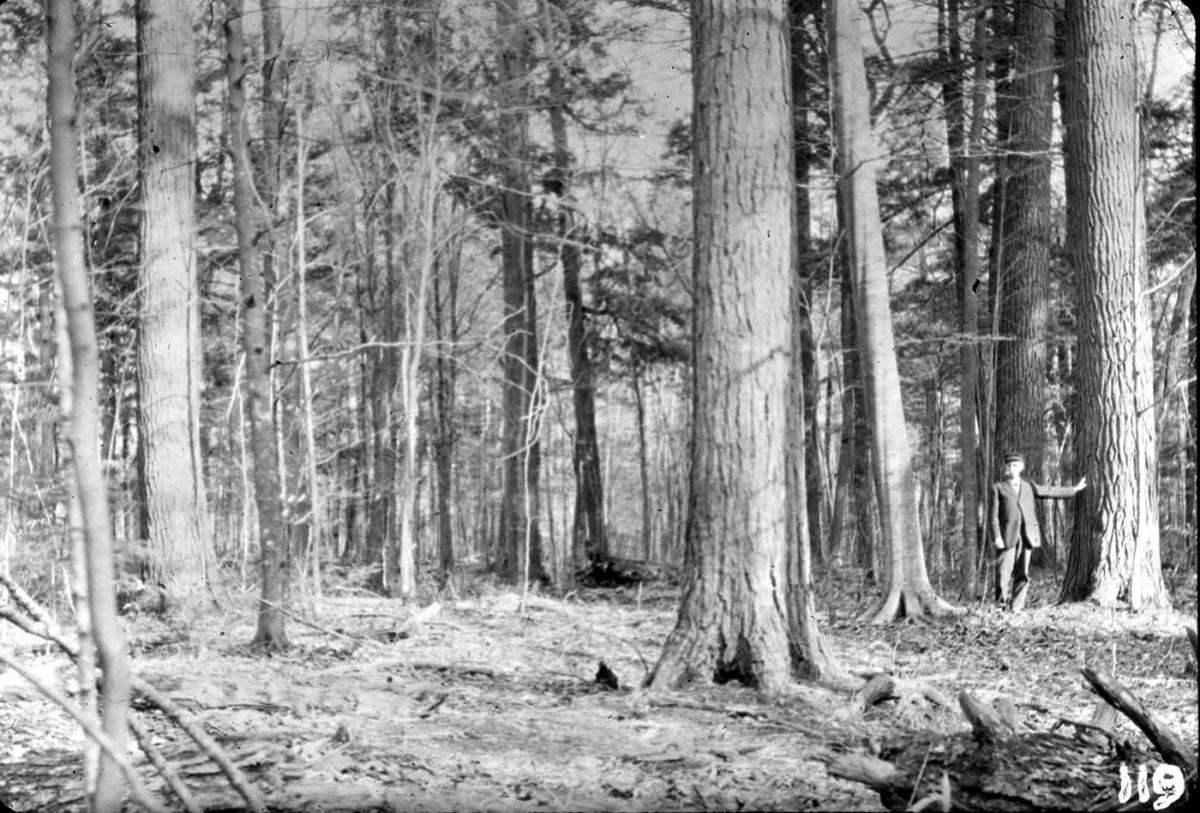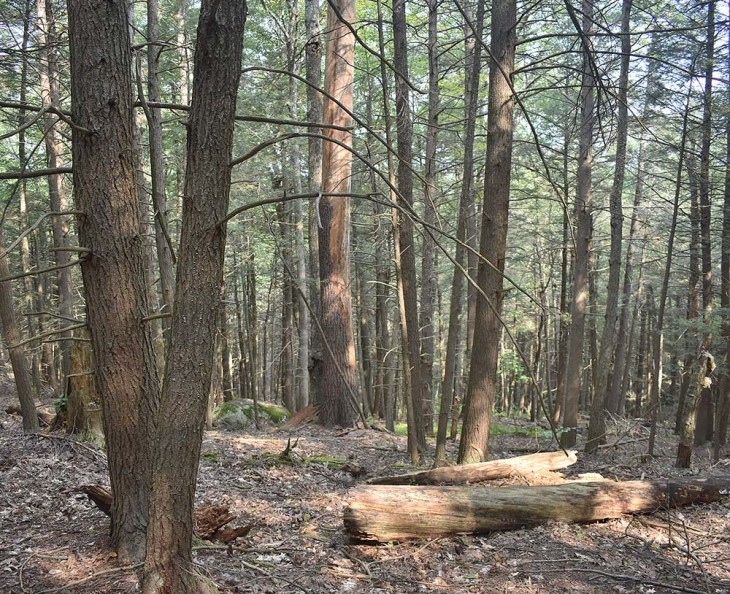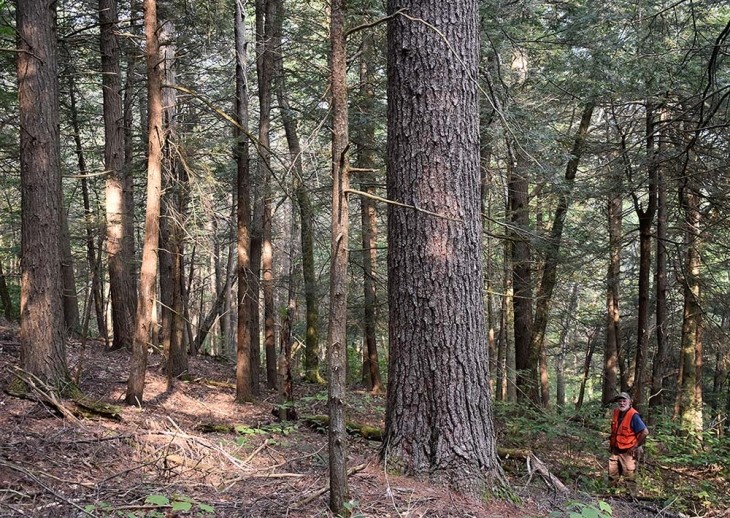
Legendary Connecticut State Forester Austin Hawes called it “the most perfect mixture of the northern and southern New England forest types” he had ever seen. The Carrington Phelps property, which Hawes surveyed in 1907, was near the Massachusetts border in the western Connecticut town of Colebrook, roughly 300 acres “of timber the equal of which it would be difficult to find” in the region. By 1912, it was gone, the state’s last substantial tract of ancient forest reduced to stumps, slash, and piles of sawdust. “It is very unfortunate the State Park movement was not started early enough to save this remarkable forest,” Hawes later wrote in his unpublished History of Forestry in Connecticut.
Forests were being cut at an alarming rate early in the twentieth century. Loss of timber resources, devastating fires, floods, and severe erosion drove a growing interest in forest conservation. In Connecticut, the Yale Forest School was started in 1900, and New England’s first state forest, Portland State Forest (now Meshomasic) in the central part of the state, was established three years later. Connecticut-born Gifford Pinchot became the first chief of the U.S. Forest Service in 1905, and in 1911 Congress passed the Weeks Act, authorizing the federal government to purchase land in the eastern part of the country for use as national forests.
Towering Trees
Contemporary ecologist George E. Nichols described the clearing of the Carrington Phelps land as “a calamity” and “little short of desecration” in an extensive retrospective of the property published in the September 1913 issue of Torreya, the journal of the Torrey Botanical Society. “The few vestiges of ancient timber that are still preserved,” he remarked about forest fragments elsewhere, “serve as little more than poor reminders of the grandeur which the forests of the past must have possessed.” Nichols, who would later chair Yale University’s botany department and serve as president of the Ecological Society of America, had extensively studied the property prior to the harvest. His vivid and detailed description offers a taxidermy in words of this magnificent stand of trees.
The land generally slopes southeast with rugged ridges on the northwest, west, and southeast rising steeply to about 1,300 feet. Two brooks meet in a valley bounded by these slopes, about 300 feet below the ridgetops. Combined as Sandy Brook, the water flows southeasterly, meanders through a wetland of red maple and alders, and passes under State Route 183. Crossing through Phelps Flat, it continues several miles to its confluence with Farmington River, the largest tributary of the Connecticut River.
Nichols was clearly awed by the mature hardwoods, well over 3 feet in diameter at breast height and “towering upward” as much as 108 feet, some clear of branches almost 60 feet above the ground. The average age of mature specimens ranged from 275 to 350 years. Beech and hemlock were the most common species, equally abundant and covering about 55 percent of the stand. About 12 percent of the trees were sugar maple; 10 percent yellow birch; 7 percent basswood and white ash; 6 percent each red oak and chestnut; and 4 percent black cherry, black birch, red maple, and white pine.
Some white pines soared more than 115 feet high. Sugar maples and yellow birches with diameters of about 2½ feet were common. One sugar maple measured almost 3½ feet thick. And nowhere in the state, Nichols observed, were there “such magnificent chestnuts.” The largest trunk had a diameter of 4¹/³ feet, and it was common to find individuals nearly 100 feet tall and branchless for half that length.
Beyond the trees’ remarkable size, Nichols was impressed with the stand’s uneven age, finding “every stage in development and deterioration . . . from the slender saplings to the rotting logs with which the ground is strewn on all sides.” He delighted in plants growing far below the canopy, writing that “the luxuriance of the underbrush here is a revelation,” although in many places “the moldy soil appears almost devoid of plant life.” Mountain laurel was common as in other woodlands, but in places he found a profusion of hobblebush and American yew, which were unusual in second-growth forests. Witch hazel, maple leaf viburnum, alternate-leaf dogwood, and Canada honeysuckle were also frequent. Nichols documented more than 50 herbaceous plants including ferns, clubmosses, and flowering species such as clintonia, asters, and trillium. He cataloged nearly 60 mosses and liverworts, “which formed a rich covering over the surface of the ground, on roots, logs, stumps and bowlders, [sic] but they also plaster the bases of trees extending up their trunks.”
Where Nichols saw a sylvan Eden, however, others saw lumber, as much as 45,000 board feet per acre. In a two-page assessment of the Phelps timber written during the summer of 1910, A.F. Kerr argued that “all of the timber is mature and should be cut at once. The best system would be to cut clear,” he wrote, although in areas continuing as forest “a selection cutting should be made.” Nichols noted that portable sawmills, improved transportation, and demand for lumber made even remote areas accessible to cutting.
Family Roots
Phelps family roots ran deep on the property, and Carrington Phelps’ decision to cut the timber two years after Kerr’s report could not have been easy. Not long after Josiah Phelps II purchased the first acreage late in the eighteenth century, an inn and farm were established. The place quickly became a center of community activity, and a popular stagecoach stop. To build farm structures, a dam and the sawmill were constructed on Sandy Brook by the early 1780s. Downstream of the ancient timber tract, it was located on the flats where crops were grown, mostly for livestock that eventually included sheep, cattle, and horses. Records reveal that in March and April 1816, for example, more than 40,000 board feet were sawn at the mill. By the mid-nineteenth century, dairy was the farm specialty, and a creamery was built. Phelps holdings grew to well over 500 acres.
When his father died in 1885, Carrington Phelps inherited the farm his great-great-grandfather had begun about a century earlier. A Yale Law School graduate, Carrington had moved to the upper Midwest where he practiced law, farmed, and became a bank president. In fiscal distress, he returned to Colebrook in 1897 to run the ancestral farm, including two mills and a dairy operation. A financial crisis caused him to sell the uncut timber in 1912.
The trees began to grow back and the property eventually descended to Carrington’s granddaughter, Nancy Phelps Blum. In 1975, she and her husband John donated more than 300 acres to the Connecticut Chapter of The Nature Conservancy, including the land where the ancient forest once stood. Designated the Phelps Research Area, the tract was transferred to the Colebrook Land Conservancy in 2009. True to its name, forest ecology research is ongoing, including a long-term monitoring project of the U.S. Forest Service. The property is to be preserved in its “natural state,” according to the Conservancy, for “compatible scientific and educational use.” Logging is forbidden, while trail maintenance and non-native plant eradication are permissible.
A Forest Regrown
Curious as to what almost 120 years of forest regrowth looked like, I spent a warm mid-September day in 2021 wandering along Sandy Brook and across the property’s southeast slope. To enhance my perceptions, I was joined by foresters Jody Bronson and Ralph Scarpino. Although neither had had previous involvement with the Phelps parcel, each came with decades of professional experience in nearby woodlands. We entered at a white wooden gate just south of where Route 183 crosses the brook. In bright red lettering, a battered aluminum sign proclaimed the Phelps Research Area, “preserved in its natural state for scientific and educational uses.” Entry required permission, the posting advised, and the Colebrook Land Conservancy had authorized our visit.
We started on an old woods road paralleling a swamp thick with alders. Soon we began ascending the slope where large pines grew among beech, yellow birch, and sugar maple. Some of the pines were straight, and more than 100 feet tall. The canopy was dense, the land rose steeply, and the ground was largely bare, although punctuated in places with clusters of hay-scented fern, partridgeberry, and clubmoss. Slender moosewood saplings grew in the understory.
Midway up the contours, impressively tall and straight red oaks grew, their rich gray bark vertically striped with silvery fissures. Here, we saw an occasional black cherry, and soon hemlock grew increasingly common, although they were not particularly large, their foliage thinned from adelgid or scale. As we neared the ridge, the ascent became more rugged, and we climbed over and around lichen-crusted ledges and rocks. At the height of land, we again stood among big pines – tall, straight, and awe inspiring.
Despite everything we knew, the forest had an ancient feel. Full of stately trees, it induced a silence of wonder and reverence in us. Species composition might be different, and the trees were not of the Brobdingnagian scale Nichols described more than a century ago, but there was something in the play of light and shadow, the feeling of enclosure, the grand columnar trunks rising skyward that brought about reverie.
We began moving westerly across the contours and gradually downslope in woods crisscrossed with deer trails. As we moved farther west and dropped in elevation, the largely bare understory became crowded with greenery, perhaps owing to a change in aspect and more moisture, Scarpino and Bronson thought. Ferns grew thickly, and the hobblebush and wood sorrel Nichols described more than a century ago were thriving. Beech and red maple became common, along with sugar maple. A cluster of tall ash grew in a draw, but the bark was blonded and the crowns thinning under assault from emerald ash borer.
Perhaps the land was most remarkable for what we didn’t see. There was no evidence of logging – no tote trails or stumps, and few multiple-stemmed trees. The foresters speculated that horse logging had probably treated the area gently, time had erased scars, and lumbermen had left nothing behind. There were also no invasive plants, nor the charcoal hearth remains so common in northwest Connecticut woods. We saw only one stump-sprouting chestnut bearing two pole-sized stems: one dead and barkless, the other still sporting leaves. The lack of spindly chestnut confirmed the huge trees Nichols found, as larger specimens are less likely to stump-sprout.
We reconnected with the woods road near where the brook rushes into the swamp and disappears among alders and red maples tinged with early fall blush. On our way back to the gate, we passed some rocks showing signs of human arrangement. Nearby was a rusted pipe and collar, likely the remains of a sawdust exhaust from a portable sawmill.
The path threaded between the slope we’d just climbed and the swamp’s edge. “These woods,” Scarpino observed with an uphill wave of his arm, “set a good baseline for what happens after a century with limited management.”
We passed some beaver-gnawed trees and low dams along the water. “There weren’t any beavers here back in 1912,” Bronson noted, “so the swamp was likely a lot smaller.” I nodded and said, “I guess there’s been some tree cutting, just not by people.”
While nature largely has its way on the Phelps Research Area, active silviculture still occurs on some of the family’s other former holdings. Along gravel Phelps Flat Road, just east and south of where the last ancient forest stood, some seven acres of straight white pine about 100 feet tall have recently been harvested on private land over a two-year period. On another visit to a different section of the forest last year, Bronson said, “Trees probably haven’t been cut here in about a century.” He guessed a yield at about 23,000 board feet an acre, with the wood likely to make excellent framing timber. I measured one of the larger stumps at 40 inches in diameter. The area had the usual ragged, unkempt look of recently logged land with a few spindly trees standing on uneven ground where tiny pines were growing thickly among wheel ruts, stumps, and slash. “Regeneration here is incredible,” Bronson said with a whistle.
Cutting that last ancient stand was a tragedy. But in this fortunate region, forests are resilient. While we can never recover the grandeur of what was lost, with time the Phelps Research Area will regain some semblance of past glory. Needs and priorities have changed since the first Phelps settled here in the eighteenth century. Still, we rely on trees for many of the same uses, even as new values such as carbon storage and respite from an increasingly frenetic world make our forests ever more valuable.




Discussion *